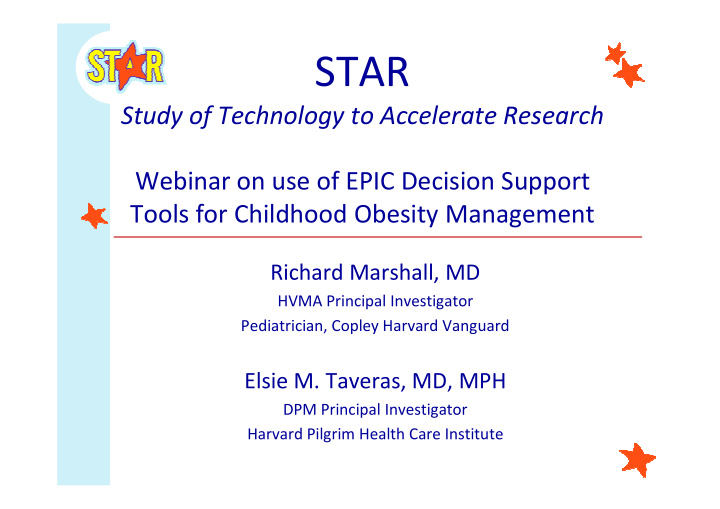



STAR Study of Technology to Accelerate Research Webinar on use of EPIC Decision Support Tools for Childhood Obesity Management Richard Marshall, MD HVMA Principal Investigator Pediatrician, Copley Harvard Vanguard Elsie M. Taveras, MD, MPH DPM Principal Investigator Harvard Pilgrim Health Care Institute
Overview of the Webinar • Study overview • Webinar Objectives • Identifying STAR Participants • Identifying STAR Participants • Introduction to the Pediatric Obesity Best Practice Alert • Introduction to the Pediatric Obesity WCC Visit SmartSet
Study Objectives 1. To increase uptake and use of research evidence on management of childhood obesity by pediatric clinicians and parents. 2. Improve quality of care for pediatric obesity. 3. Improve obesity outcomes among children 6 to 12 years of age.
S tra te g ie s to b e T e ste d • Clinician Strategies: – Obesity Best Practice Alert – Well Child Care + Obesity SmartSet – SmartSet for Obesity Follow up visits – – Clinician website: Clinician website: • Searchable database for patient physical activity resources • Printable educational materials • Comprehensive list of local weight management programs • Parent Strategies – Text messages, health coaching calls, mailings
Study Design: RCT Sample size = 75-100 patients/practice
Webinar Goals • Introduce the new Obesity Best Practice Alert (BPA) and SmartSets; • Review the features of each decision support tool; • Describe how these tools will assist clinicians in meeting the existing recommendations for obesity screening and management; • Describe how these tools will assist clinicians in meeting existing HEDIS measures.
Criteria for Inclusion in STAR 1. Age 6-12 years old before upcoming WCC visit 2. BMI > 95 th percentile 3. WCC visit within the last 15 months 4. At least 1 English-speaking parent 4. At least 1 English-speaking parent 5. No siblings previously enrolled 6. No plans to leave HVMA 7. No chronic conditions affecting growth 8. Approved by clinician
Before the WCC Visit… • Prior to the patient’s WCC Visit, s/he will have: 1. Received letter introducing and explaining the STAR study 2. Completed a baseline survey over the phone 2. Completed a baseline survey over the phone with research staff 3. Provided informed consent to participate in the study 4. Patients in Clinician/Parent Ix arm will be sent the “Reminder of Upcoming Visit” letter
I d e n t i f y i n g S t u d y Participants • Enrolled STAR participants will be identified with a code in the problem list:
Sample STAR patient • 10 year old boy with a BMI just above the 95 th percentile at his most recent WCC visit. • Obesity noted in his problem list. Labs deferred at his last visit. Counseling provided to the family on nutrition and physical activity. nutrition and physical activity. • Gained 12 pounds since his last visit 1 year ago. • Generally healthy but family history significant for Type II Diabetes and hypertension in his father’s side.
WCC Workflow • Patient’s height and weight measured and entered into Epic by medical assistants • Since the patient’s BMI > 95 th percentile, the Best Practice Alert will be highlighted in the Visit Navigator
WCC Visit Workflow • Clicking on the Best Practice Alert flag will take the clinician to the actual BPA: • Check the WCC Obesity SmartSet and then Accept to view • Click on the “Jump to” links to go directly to that item • BPA will also “pop up” when clinician goes to enter orders
Navigating the Obesity WCC Visit SmartSet • The template for the progress note includes items standard for a well child visit and incorporates STAR behaviors for obesity management
Navigating the Obesity WCC Visit SmartSet • Diagnoses – Physical Exam Diagnosis and Obesity are pre-selected for all patients. Obesity code meets the HEDIS requirement. – Diagnoses are listed by most common, then alphabetically.
Navigating the Obesity WCC Visit SmartSet • Lab Orders – Fasting lipid profile is recommended for all 6-12 year old children with BMI ≥ 95 th percentile – If age 10 years and patient has other risk factors, test fasting glucose, ALT and AST biannually – Other labs listed are only if clinically indicated.
Navigating the Obesity WCC Visit SmartSet • Check appropriate Well Visit listing
Navigating the Obesity WCC Visit SmartSet • Referrals – Link to website for list of external weight management programs – Check type of referral made – Check Nutrition HVMA External to indicate a referral to an external program
Navigating the Obesity WCC Visit SmartSet • Counseling – Dietary Surveillance and Exercise Counseling are HEDIS measures – Counseling topics will not be pre-selected and need to be selected for HEDIS if they were performed – Check LOS where appropriate
Navigating the Obesity WCC Visit SmartSet • Click Follow Up Module to create follow up Instructions for the patient • Follow Up instructions will be printed on AVS
Navigating the Obesity WCC Visit SmartSet • Patient Instructions/After Visit Summary – STAR Kids Recommendations will be pre-selected to print on the AVS – Link to website with STAR patient resources, searchable physical activity database and weight management directory included in Patient Instructions section
Clinician Website • www.hvmastarstudy.com • Resource for patient education materials • Features – Links to Expert Committee and USPreventive Services Task Force Recommendations for Clinicians Recommendations for Clinicians – Link to list of local weight management programs – Age appropriate patient materials focusing on all key STAR behaviors – Colorful materials that can also be printed in black and white – Searchable Physical Activity Resource database
Your Support Team • Study staff at DPM and HVMA will support clinicians. • Chrissy Horan, DPM Project Manager – chrissy_horan@hphc.org chrissy_horan@hphc.org • Amy Marston, HVMA Project Manager - Amy_Marston@AtriusHealth.org • Stephanie Hills, Business Analyst – stephanie_hills@vmed.org
Questions? Q u e stio n s?
Recommend
More recommend